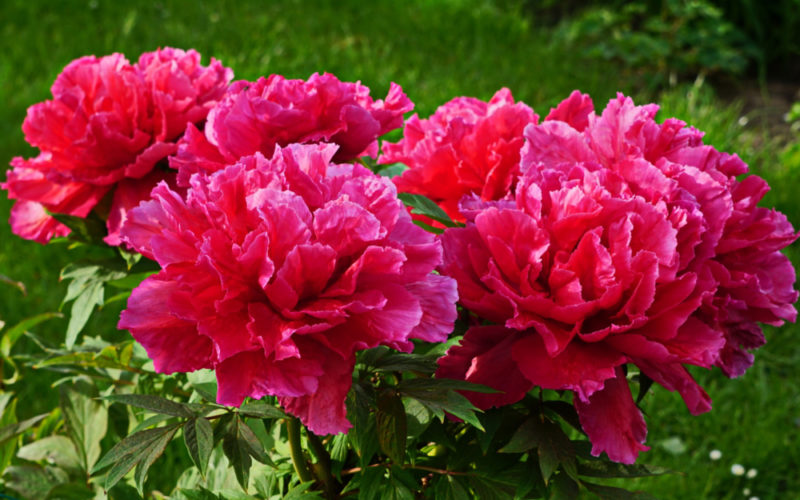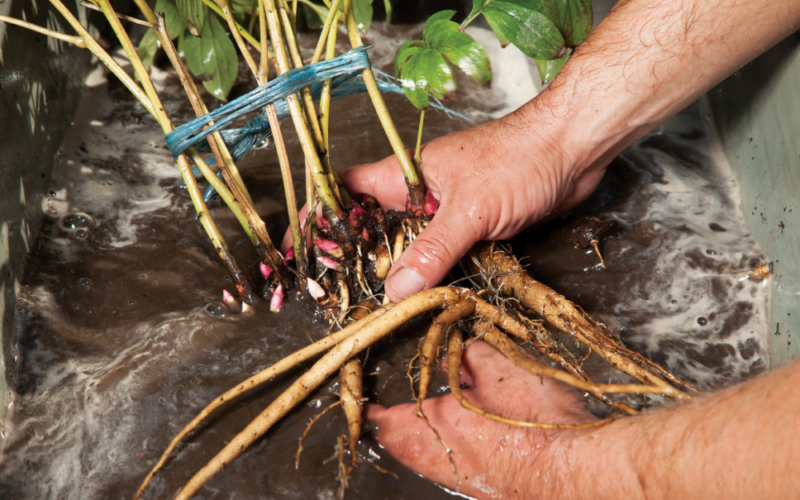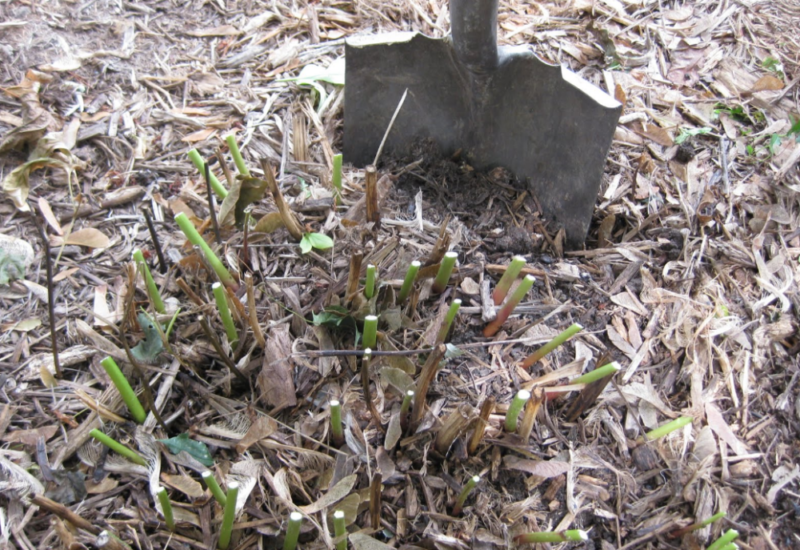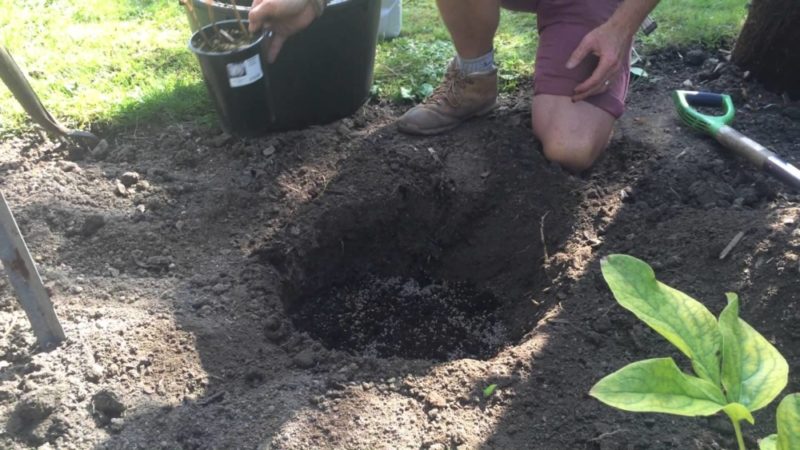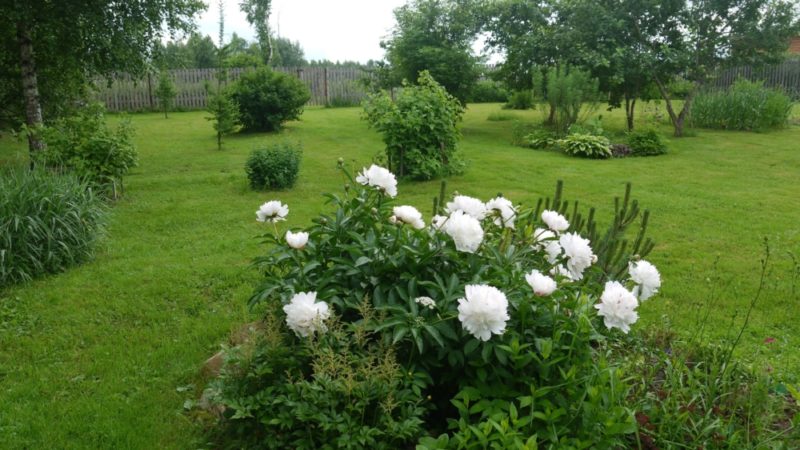A feature of the garden handsome is the constancy of the place of growth, but situations arise when peonies need to be transplanted. The reasons for the inevitable transplant, the rules and care for the bush are the information that the owner of the flower needs to know.
Material Content:
The need for transplanting peonies
Ordinary specimens of any perennial varieties, tree-like or herbaceous, without problems grow in one place up to 50-80 years.
But varietal peonies must be transplanted after 7-10 years, then they are overgrown with greenery, buds are smaller, their number is reduced.
That is, it is necessary for plant renewal.
Immediate transplantation is subject to bushes planted in areas of spring flooding. If you do not transplant in time, then the roots will rot forever.
And it is also necessary to change the place of growth for flowers, caught in the shade of large trees, growing in a draft, depleted or infected with parasite soil.
Another reason is the various physical obstacles that require moving the bush, for example, changing the landscape design.
Terms and conditions
A favorable time for a planned transplant is considered autumn. But, if the need arose, you can transplant at any stage of the growing season. Only then does the plant adaptation period increase, and flowering is delayed until next year.
In the spring
During this period, it is necessary not to miss the time, and transplant, while still on a peony, pink sprouts. This phase is not the same in different regions, April or May.
The method of transplantation is transshipment, while it is impossible to divide the bush for propagation, it is important not to damage the suction roots, then the restoration of the plant will be faster and more successful.
Summer
Favorable time comes only at the end of August, from about the 15th. Growth buds and flower ovaries have already been laid, you can safely touch the bush for transplanting and divide for reproduction. If the plant becomes ill - transplanted immediately, without waiting for August or September.
Before digging the bush, the aerial part is cut, leaving the cuttings 15-20 cm long. Rhizomes are freed from the ground, all parts are treated with fungicides, transplanted to a new place. Be sure to protect from sunlight, heavy rains.
Be patient - it will take a long time to restore the bush.
Fall
Peonies can be transplanted in the fall to a new place 1-1.5 months before the onset of frost, so that the plant has time to take root and prepare for wintering. Usually this is mid-September. This is the most painless period for changing the place of a peony; next spring the plant will be ready to bloom.
The exact date for the transplant depends on the climatic features of the region. Experienced gardeners also adhere to the recommendations of the lunar calendar.
How to transplant flowers
Transplanting perennial peonies has its own subtleties. Perennial roots grow into huge rhizomes, extending deep into the ground by 80-100 cm, while they are quite fragile. If the bush is not transplanted in time, then over time it will be impossible to extract the plant from the soil without damaging the roots.
It is recommended to transplant peonies of some varieties more often, after 5-7 years.
In this case, one must take into account how to dig out a bush without causing harm:
- Trim the stems of the plant to 10-15 cm.
- Dig a groove around the bush with a shovel in a radius of 50 cm, if the plant is old, then the distance should be greater.
- Fork the peony, pull it out of the ground, gently picking it up from below.
In no case should you pull on the stems of the plant, as growth buds are damaged.
Further:
- Dug rhizomes free from the earth.
- Washed with water.
- Relate to the shade for 4-5 hours to tighten.
In the shade, the rhizomes become slightly limp and become less fragile, more ductile and supple for dividing the bush and processing.
After several hours, sanitization is carried out:
- remove sick, damaged, dry areas, shorten too long rhizomes at an angle of 45 °;
- if necessary, volume roots are divided into parts;
- soaked for another couple of hours in potassium permanganate or other fungicide for disinfection;
- dried;
- sections can be further treated with crushed activated carbon or sprinkled with ash.
Division of the bush should be carried out only with a sterile tool. Delenka should have at least 5-6 kidneys.
Experienced gardeners suggest dipping a peony in a talker before planting:
- 2 tablets of heteroauxin;
- 50 g of copper sulfate;
- clay;
- water.
From clay and water, make a creamy mixture, add the previously dissolved tablets and copper sulfate to the resulting mass and mix thoroughly. Dip the peonies rhizomes into it, so that the talker fills the entire surface of the roots, then remove and dry.
The resulting crust will protect the roots and small rhizomes from fragility during planting and possible parasites. When using talkers, slices do not need additional processing.
For the active development and lush flowering of a perennial peony, the right landing site is chosen. This is a site lit from all sides, without drafts, with good drained nutrient soil.
Experienced growers are advised to prepare a landing pit in advance:
- dig a hole 50x50 cm and a depth of 80 cm;
- beaten brick, pebbles or expanded clay are poured to the bottom of the pit to the third of the pit to create drainage;
- 2/3 of the holes are filled with nutrient soil, for example, humus or compost soil;
- top layer - excavated soil is mixed with sand (for looseness), wood ash and 20 g of superphosphate, 10 g of copper sulfate are added. If the soil is acidic, it is deoxidized with dolomite flour (lime can be added in advance for 6 months).
Fill the well with this mixture. Spill with plenty of water.As the earth shrinks, it is added. Peonies prefer stable, settled soil. In a couple of weeks, the landing pit will be ready.
Planting is carried out in accordance with agricultural requirements for all varieties of peonies. In a designated place with a ready-made landing pit, immerse the bush so that from the bud of growth to the surface of the soil there is a maximum of 3 cm. You can’t deepen the ovaries very much, otherwise flowering can not wait. The soil is carefully crushed, trying to fill the voids. Abundantly watered.
Caring for a bush in a new place
When transplanting peonies in the fall to a new place, it is necessary to warm the bush for the winter. You can spud with rotted manure and cover it with dry leaves. Just do not forget to remove the shelter in early spring so that the sprouts do not mate. It is not recommended to use peat as a heater, as it strongly oxidizes the soil.
Care next season comes down to such events:
- thorough weed removal and regular loosening of the soil;
- rare but plentiful watering in dry periods, especially in hot summers (at least 15 liters of water under the plant 1 time per week);
- fertilizing with complex fertilizers with a predominance of nitrogen (for building green mass and roots). The first - at the end of May, after 2 weeks, repeat the fertilizer.
If suddenly the peony was about to bloom, it is necessary to pluck out all the buds that are emerging in order to strengthen the root system. Do not spare the ovaries, they still will not be full, but next year the plant will give numerous lush flowers.
In autumn, when the stems and leaves begin to fade, you need to cut the tops to the base. Warm with humus and dry leaves.
Transplanting peonies in the fall is the most favorable time. If the transplant is done correctly, then lush flowering in a year or 2 is guaranteed.


